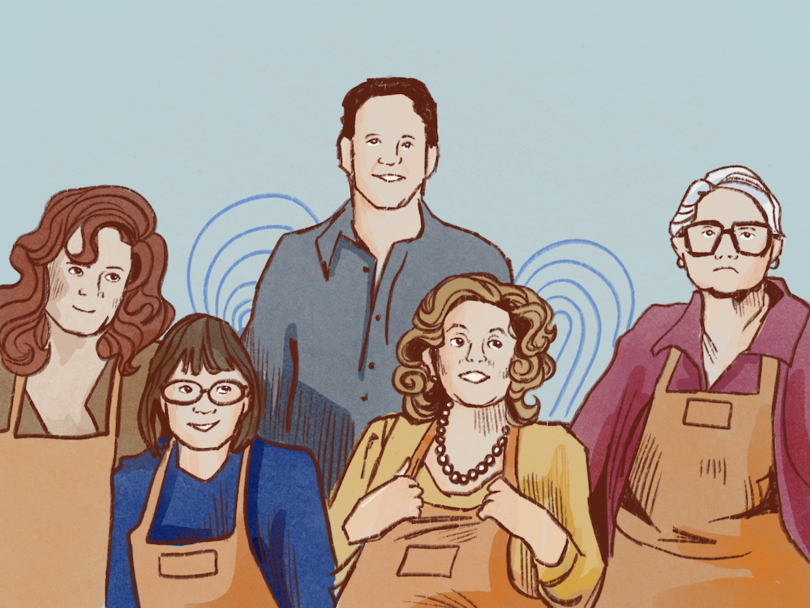‘Nonnas’ highlights Italian-American culture with family-friendly comfort

Enoteca Maria hires nonnas as the chefs. These grandmothers are the glue of “Nonnas” and the real-life restaurant, serving the warmth and comfort of family recipes. Hannah Mesa | Illustration Editor
Get the latest Syracuse news delivered right to your inbox.
Subscribe to our newsletter here.
Like a steaming plate of homemade spaghetti and meatballs dusted with Locatelli cheese, “Nonnas” serves up a warm, nostalgic celebration of Italian-American heritage.
This is director Stephen Chbosky’s first film since his 2021 adaptation of “Dear Evan Hansen,” which received harsh criticism for poor vocal performances and emotionally deceptive writing. With Netflix exclusive “Nonnas,” Chbosky traveled a safer path by avoiding experimentation, instead creating a cozy, family-friendly flick.
The film follows the true story of Jody “Joe” Scaravella (Vince Vaughn). After his mother, Maria, dies of cancer, Joe uses his inheritance to purchase a vacant restaurant on Staten Island, naming it Enoteca Maria — an homage. He opens the eatery with the help of his childhood best friend, Bruno (Joe Manganiello), and his wife, Stella (Drea de Matteo). The real-life restaurant opened in 2007 with a distinctive Italian dining experience.
Joe struggles to recreate family dishes, specifically his nonna’s Sunday gravy. As he longs for the past, he discovers the idea for Enoteca Maria that sets it apart from other Italian joints: real-life nonnas — or grandmothers — as the chefs.
Joe first recruits Antonella (Brenda Vaccaro), who he meets at a Staten Island market, and Roberta (Lorraine Bracco), Maria’s lifelong best friend. Rounding out the nonnas, former nun Teresa (Talia Shire) is hired through Craigslist, and Joe convinces Gia (Susan Sarandon), Maria’s hairdresser, to become the pastry chef.
The film’s cast is no stranger to Italian sagas. Casting de Matteo, Bracco and Shire — stars of “The Sopranos,” “GoodFellas” and “Rocky” — proved to be an effective choice by presenting the audience with familiar faces. These veterans of industry share Italian ancestry, making the film more authentic.
The nonnas are the glue of the film (and the real-life restaurant). Among the film’s grief and loss, they provide much needed comic relief. Antonella and Roberta are at each other’s throats from the moment they meet, arguing about which part of Italy is superior: Bologna or Sicily. Tempers literally flare when a food fight results in Roberta’s capuzzelle igniting in flames, destroying the oven and damaging the wall.

Lily Zuckerman | Asst. Digital Editor
For a film that’s loud in its performances and celebration of Italian culture, “Nonnas” utilizes subtlety in its storytelling — particularly involving Olivia (Linda Cardellini), Joe’s love interest. Joe went to high school with Olivia, Antonella’s neighbor, and dumped her at prom. The two are reunited when Joe meets Antonella at the market. Now a widow, Olivia hasn’t moved on from her husband’s death, still wearing her wedding ring on her left hand.
By the end of the film, Enoteca Maria is bursting with life after an unexpected food critic review in the newspaper gushes about the family-style restaurant. With patrons in the background, dancing around the restaurant, Joe and Olivia lock eyes. The camera zooms in on Olivia’s folded hands, the wedding ring moved to her right ring finger, signifying she’s ready for a new relationship.
“Nonnas” is economical with its runtime, highlighting the heart of the story: food and family.
The straightforward themes work. Like Chbosky’s directing, “Nonnas” plays it safe, lacking any real risk or flashiness. While Vaughn gives a solid, sentimental performance, his character can be flat at times. Joe copes with the death of his mother and goes through common business obstacles like failing a health inspection and financial stressors. This commonality results in minimal character development. The only major progression is the spark we see with Olivia at the very end of the film.
At the same time, playing it safe and using simple tropes are exactly why “Nonnas” succeeds. Will it be touted as highly as a movie like “Citizen Kane”? No. But “Nonnas” offers something more meaningful. It’s reminiscent of the smells, tastes and satiated feelings from one’s childhood. It brings up laughter-filled memories from around the dinner table, surrounded by the warmth of family. And it’s a reminder that the loved ones lost are still alive in some shape or form.
Like Joe says about his mother and nonna, “Food is love, and as long as I have their food, I’m gonna have them.”
The target audience of “Nonnas” is obviously Italian Americans, but the film conveys a universal experience. It’s a heartwarming story centered around food and family recipes — the ultimate form of cultural preservation. That’s why the real Joe Scaravella, who makes a cameo in the movie as a restaurant patron, chose to invite grandmothers from all over the world to cook at Enoteca Maria.
The film’s affectionate soundtrack, which features traditional Italian folk songs like Mario Rusca’s “Tarantella Napoletana” gives “Nonnas” its warmth, but the highlight is Billy Joel’s “Scenes from an Italian Restaurant.” This 1977 tune plays while Joe admires the outside of Enoteca Maria, soaking in the tribute to his mother. The moment perfectly encapsulates the mood of the film: nostalgia.






